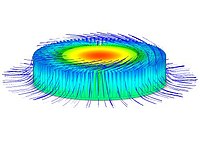
Photo from wikipedia
Abstract This study numerically investigates a micro-pin-fin heat sink (MPFHS) to improve cooling capability and productivity of MPFHS. It was assumed that the flow is turbulent, steady, and incompressible. Turbulence… Click to show full abstract
Abstract This study numerically investigates a micro-pin-fin heat sink (MPFHS) to improve cooling capability and productivity of MPFHS. It was assumed that the flow is turbulent, steady, and incompressible. Turbulence was modeled using the k − e turbulence model. For this purpose, the effects of different pin-fin configurations, including RS, ET, and ES, height, fluid velocity, in terms of heat transfer, pressure drop, as well as temperature variation between the inlet and outlet were studied in detail. Moreover, a comparison investigation with experimental results was carried out. Finally, it is found that the RS configuration possessed maximum heat transfer while yielding the maximum pressure drop. Smaller distances between the pins improved heat transfer but enhanced the convective heat transfer coefficient and increased pressure drop. Contrarily, an increased pin length and diameter enhanced pressure drop and heat transfer for all the configurations. This was more obvious in the RS configuration.
Journal Title: Case Studies in Thermal Engineering
Year Published: 2021
Link to full text (if available)
Share on Social Media: Sign Up to like & get
recommendations!